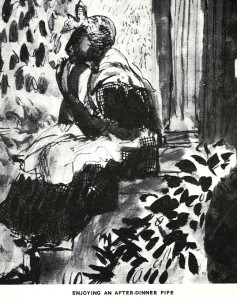Diana Kennedy introduced Mexican haute cuisine to American tables with her landmark 1972 cookbook, The Cuisines of Mexico, introduced by Craig Claiborne. Kennedy recommended viable substitutes in an era when Mexican produce was unavailable, and provided significant procedural details. I have substituted corn oil for lard, diced, dried fruit for candied fruit, and canned tomatoes for fresh.
There is always an exclamation of pleasure and surprise when a cazuela of golden, puffy chiles rellenos sitting in their tomato broth is presented at the table. If you have eaten those sad, flabby little things that usually turn up in so-called Mexican restaurants in the United States as authentic chiles rellenos, you have a great surprise in store.
Here is yet another prime example of the fine feeling the Mexicans have for texture in their food: you bite through the slightly crisp, rich chile poblano to experience the crunch of the almonds and little bits of crystallized fruits in the pork filling. Then there is the savory broth to cut the richness of the batter. Assembling the chilies may seem like a long laborious task, but it is no more complicated and time consuming than most worthwhile dishes, and this dish is certainly worthwhile.
Cut 3 lbs. lean boneless pork into large cubes. Put them into a sauce pan with one large white onion, chopped, and two minced cloves of garlic, a teaspoon or so of salt. Cover with cold water, bring to a boil, lower heat and cook until just barely tender, maybe 45 minutes. Let the meat cool in the broth. Strain the meat, reserving the broth, then shred or chop it finely and set it aside. Let the broth get completely cold and skim off the fat. Reserve the fat.
Cook about a cup of chopped onion with 3 minced cloves of garlic in about a half cup of corn oil without browning. Add meat and let it cook for a few minutes. Add a tablespoon of freshly-ground black pepper, a teaspoon of ground clove, and a teaspoon of cinnamon along with 2 tablespoons slivered blanched almonds, 2 tablespoons raisins, and three or sour finely-chopped dates. Add two cups crushed tomatoes and increase heat. Cook until meat mixture is almost dry.
In a blender or food processor, puree two cups diced tomatoes with a half a white onion, coarsely chopped, and two minced cloves of garlic until smooth. the juice extracted from their seeds, with the onion and garlic until smooth. Place the fat skimmed from the meat broth to a pan, add the tomato puree, two bay leaves, a teaspoon coarsely-ground black pepper, and a half teaspoon each ground cloves and dried thyme.
Add 3 cups of the reserved pork broth, continue cooking on high heat for 15 minutes, then lower heat and simmer until slightly thickened. You don’t want a thick sauce, you want it brothy. Add salt as necessary.
Roast 6 large poblanos on an open flame or under a broiler until the skin blisters and burn. Make sure they don’t get overcooked or burn right through. Wrap the chilies in a damp cloth or plastic bag and leave them for about 20 minutes. The burned skin will then flake off very easily and the flesh will become a little more cooked in the steam.
Make a slit in the side of each chili and carefully remove the seeds and veins. Be careful to leave the top of the chili, the part around the base of the stem, intact. Rinse the chilies and pat them dry. Stuff the chilies until they are well filled out. Set them aside on paper toweling while you make the batter.
Separate 4 eggs. Beat the whites until they are stiff, but not too dry. Add a few dashes of salt and mix in the four egg yolks one by one, beating well after each addition. Pat the chilies completely dry (or the batter will not adhere) and sprinkle them lightly with flour. Coat them with the batter. Fry the chilies in hot corn or safflower oil, turning them from time to time, until they are an even gold all over. Drain the chilies on the paper toweling, place them in the tomato broth-it should come about halfway up the chilies- and bring them up to heat on a low flame.
You can prepare the stuffing and the sauce the day before, and skin and clean the chilies. But do not put the stuffing into the chilies until about 2 hours before cooking. You can coat and fry them just before your guests arrive and leave them on paper toweling in a warm spot until the last moment, when they can be just warmed through in the tomato broth. In Mexico they are served by themselves, just before the main course. But they make a very good main course in which case you could serve two small chilies.
If you have any picadillo left over it will freeze very well; reheated, it makes a very good filling for tacos. The tomato broth, too, will freeze and can be used for other dishes.











